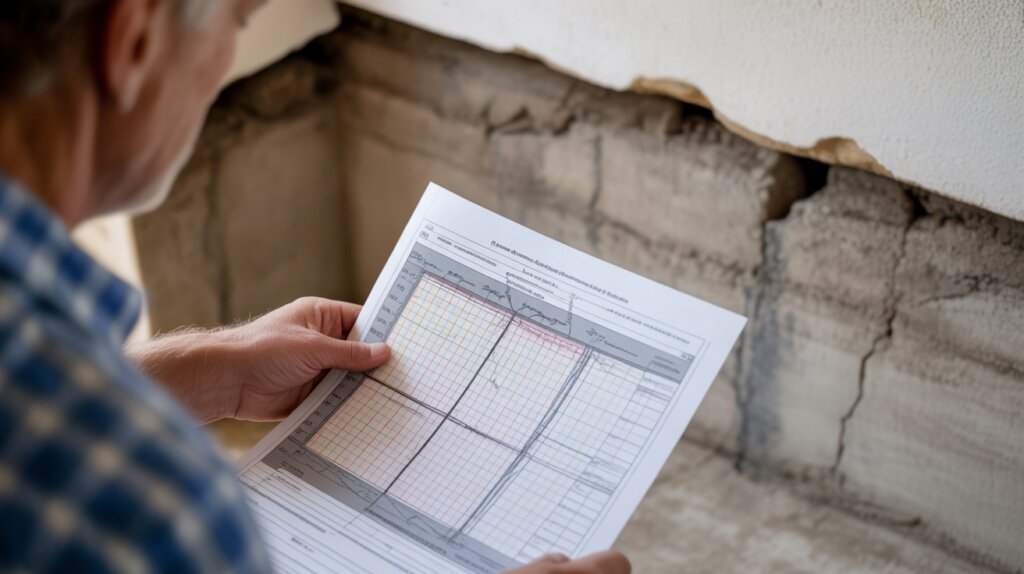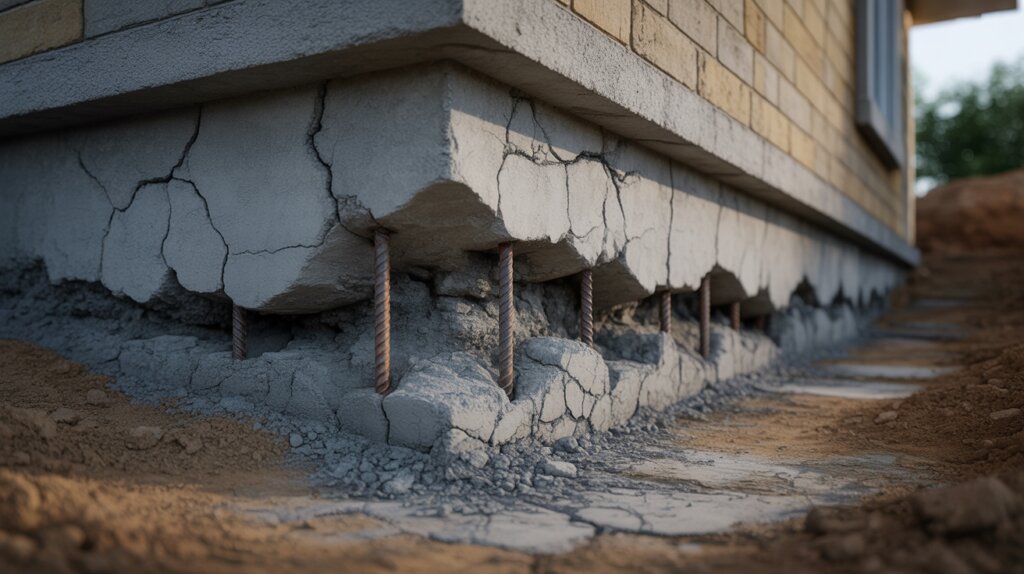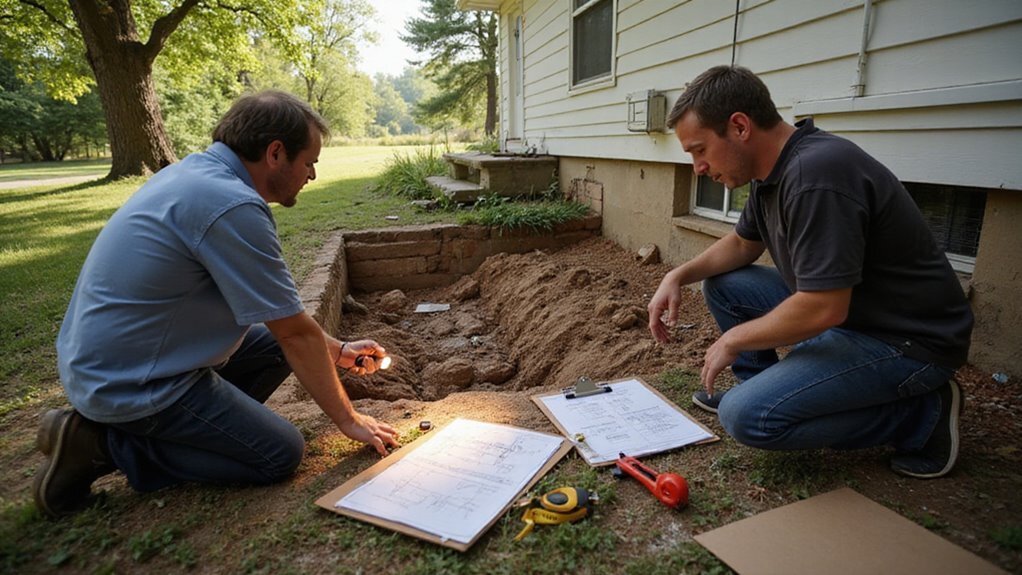Cracks creeping along your walls or sloping floors can be alarming. These signs often point to possible foundation problems in your home. Many homeowners feel unsure about what these issues mean for their safety and property value.
Such problems can quickly get worse if you ignore them. You might feel overwhelmed by repair options or worry about high costs. Not knowing the true cause can lead to bad decisions and wasted money.
A structural report gives you the clarity you need to act wisely. A structural report explains the real condition of your home’s foundation and guides your next steps.
With expert insight, you can plan repairs that fix the real problem. This blog will guide you through structural reports so you can protect your home and your investment.
Key Takeaways
- Structural reports provide an expert assessment of a home’s foundation condition, identifying safety risks and necessary repairs.
- Common foundation issues include wall cracks, uneven floors, sticking doors, and water drainage problems.
- Reports use clear terminology and severity ratings to describe the extent and urgency of foundation problems.
- Recommended repairs may involve underpinning, waterproofing, or drainage improvements, with cost estimates included.
- Buyers, sellers, and lenders rely on these reports to determine property value, negotiate repairs, and ensure safe transactions.
What Is a Structural Report?

A structural report is a document that explains the condition of a building’s structure. A qualified structural engineer prepares this report after a thorough inspection. It gives clear details about the safety and stability of your home. The report checks important areas like the foundation, walls, and support beams. It lists any issues that could affect your home’s safety or value. If problems are found, the report will suggest ways to fix them or recommend further checks.
Additionally, a comprehensive structural report can help protect homeowners from future financial liabilities related to legal defects or structural failures. Homeowners can use a structural report when buying, selling, or maintaining a property. This report helps you make informed decisions. If you want to avoid expensive repairs later, you should consider getting a structural assessment.
Common Signs of Foundation Problems
Foundation problems often show clear warning signs. Cracks in walls, uneven floors, or doors that do not close are common signs. These issues suggest your foundation may be moving. Proper water drainage is essential for maintaining foundation stability and preventing further damage. Gaps around windows or separating bricks on the outside can also signal trouble.
Changes in soil, like erosion or poor drainage, often cause these issues. If you see water pooling near your home, your foundation could be at risk. Proper water drainage is important for foundation health. If soil stays too wet or washes away, the foundation may weaken. Addressing foundation issues early can prevent serious structural damage.
The Role of Structural Engineers in Home Inspections

When you hire a structural engineer for a home inspection, you’re getting expert analysis on foundation stability and overall safety. They’ll identify structural risks that could affect your home’s value or safety. Rely on their assessment to make informed decisions about repairs or purchases. Understanding step-up in basis can also help you evaluate potential tax implications if you decide to sell the property in the future.
Assessing Foundation Stability
A home’s foundation must be stable for safety and long-term value. If the foundation is not stable, serious problems can develop. A careful assessment can help you spot these issues early.
Soil stability and moisture levels are key factors to check. Engineers look at whether the soil can hold the home’s weight. They also check for any shifting or settling that may signal deeper problems.
Moisture can weaken soil if drainage is poor or water collects near the house. If engineers find high moisture, repairs may be needed. Checking soil and water conditions helps you understand your foundation’s current state.
This assessment lets you decide if repairs or prevention are needed. If you act early, you can avoid costly damage later. A stable foundation protects your home over time.
Identifying Structural Risks
Structural risks are often hidden and need expert attention. These risks can cause major damage if not found early. A structural engineer can spot problems that most homeowners miss.
If there are cracks or uneven floors, you may have a structural issue. Warning signs include shifting soil or water around the foundation. These problems can weaken your home over time.
If you see diagonal cracks, it might mean your house is moving. Uneven settling often points to soil stability issues. Damp walls or floors usually signal water intrusion.
If a wall bows or a door does not close, the framing may have shifted. These changes can affect the entire structure. Early detection can help prevent bigger repairs later.
Key Components of a Structural Report
When you review a structural report, you’ll find it covers three crucial areas: visual inspection findings, the structural engineer’s assessment, and recommended repair solutions. Each section gives you clear, actionable information about your home’s condition and what steps to take next.
Understanding these components helps you make informed decisions about repairs and maintenance. Additionally, recognizing the presence of liens on the property can be vital, as unresolved liens may impact the feasibility of certain repairs or sales. It’s also important to consider how the report aligns with market value and whether the repairs are manageable within your budget and timeline.
Visual Inspection Findings
Inspectors use visual inspections to check the true condition of a home’s structure. They carefully look at all areas they can reach. If problems are seen, these are noted right away.
Inspectors look for signs of trouble, such as cracks in the foundation. They check for water problems like damp spots or mold. If any of these are found, they may show bigger issues.
Inspectors write down their observations and take photos. These records are added to your structural report. If you need repairs, this evidence helps guide your next steps.
Structural Engineer’s Assessment
A structural engineer’s assessment provides a detailed look at your home’s foundation issues. The engineer examines more than just visible cracks. Their goal is to find the main causes of any movement or settling.
The engineer checks how weight is spread across the foundation. They also study moisture patterns and the soil under the house. If needed, they use tools to measure the strength of the structure.
The report lists all problem areas and notes any signs of instability. Engineers look for warning signs that may require extra support or soil repairs. This assessment helps you know if the damage is serious or only cosmetic.
Recommended Repair Solutions
A thorough report lists specific repair solutions for your home. It matches repairs to the exact problems found during the assessment. You will see clear recommendations for your home’s structural issues.
If your house has uneven floors or cracked walls, the report may suggest underpinning with piers. This method helps restore the foundation’s strength. If the soil is unstable, it may recommend improving drainage or using moisture control systems.
Each solution includes a simple explanation of what will be done. The report also lists the materials and steps needed for repairs. This helps you understand the process and make informed decisions.
How Foundation Issues Are Assessed
Foundation issues are checked through visual inspections and measurements. Inspectors use special tools to find and record signs of damage. If problems are found, they document each detail for further review. Regular market analysis can help determine the severity of issues and their impact on home value. Inspectors look for uneven floors or doors that do not close right. They also check for cracks in walls and floors.
If cracks are found, they note their size and direction. Laser levels help measure floor height changes. Moisture meters show if water is present in the foundation. Soil probes test the ground around the house. These methods help inspectors find all possible problems. Each step ensures the foundation is checked fully. Using advanced diagnostic tools can enhance the accuracy of the assessment. If any issues are found, the results guide the next steps for repairs.
Typical Causes of Foundation Damage

Foundation damage often happens when certain conditions are not controlled. Soil settlement is a main cause. Shifting or sinking ground can lead to cracks and uneven support.
If the soil is not packed tightly enough during construction, problems can occur. Too much or too little moisture in the soil can also cause movement. Water from rain or leaks can make soil expand, shrink, or wash away. Proper soil compaction is crucial to prevent future issues.
Poor drainage is a frequent reason for water buildup near foundations. Plumbing leaks can worsen soil instability. Tree roots may push against the foundation, causing cracks.
Seismic activity can move the ground suddenly and damage the foundation. Poor building methods can leave the foundation weak. Knowing these causes helps you spot and prevent foundation issues. Additionally, proper foundation inspection is essential for early detection and effective repair strategies.
Reading and Interpreting Technical Terminology
When you read a structural report, you’ll encounter terms and phrases that may seem unfamiliar at first. Understanding common structural report terms and decoding engineering jargon helps you make informed decisions about your home. Let’s break down the language so you can interpret the findings with confidence. Recognizing foundation issues and their potential impact on property value can also guide your decision-making process. Being aware of the timing involved in addressing these problems can help you plan effectively for repairs or future sales.
Common Structural Report Terms
Technical language in a structural report describes the condition of a building. Understanding these terms helps you make informed decisions about repairs and costs. If you know what they mean, you can better plan your renovations.
Some common terms include “differential settlement,” “deflection,” and “shear crack.” Differential settlement means the foundation is sinking unevenly, which can affect the building’s stability. Deflection is when beams or floors bend or sag, showing possible structural weakness.
A shear crack is a diagonal crack caused by shifting forces in the structure. This type of crack can be a sign of movement in the building. If you recognize these terms, you can discuss repairs with confidence and set priorities.
Decoding Engineering Jargon
A structural report uses technical words to describe problems with your home. Understanding these terms helps you know what is happening to your house.
Differential settlement means the foundation does not sink evenly. This often happens if the soil under your home is not the same everywhere.
Expansive clay is soil that grows bigger when it gets wet. This swelling can push against your foundation and cause damage.
Deflection describes any bending or movement in your home’s structure. If you see this term, the building may not be staying straight.
Shear cracks are diagonal breaks in walls or foundations. If these appear, your home might be under a lot of stress.
If you learn these words, you can better understand your structural report. This knowledge helps you make smarter choices about repairs.
Severity Levels of Foundation Problems
Severity levels show how serious foundation problems are. Structural reports use minor, moderate, or severe to describe the issue. Each level needs a different response. Finding the right real estate agent can help you navigate repairs and sale options effectively. Understanding local market conditions can also influence your decision-making process. Minor foundation issues include small cracks or slight settling.
Homeowners should monitor these and do routine checks. If problems do not worsen, repairs may not be needed. Moderate problems often show as uneven floors or doors that stick. These usually need reinforcement or soil stabilization. Early action can prevent bigger issues.
Severe foundation problems mean large cracks or major shifting. Homes with these signs need immediate expert help. Quick intervention can limit further damage. If you understand these severity levels, you can act appropriately. Always check with a professional if you are unsure. This approach protects your home and safety.
Recommended Repair Methods and Solutions
When a structural report finds foundation problems, you must repair them to protect your home. The report will list the issues and recommend solutions. You should always choose proven repair methods for best results.
Foundation reinforcement and waterproofing are common repairs. Qualified professionals can suggest the best options for your home. If you follow their advice, you can stop further damage.
Foundation reinforcement and waterproofing are key repairs—experts can recommend the best solutions to prevent further foundation damage.
Underpinning strengthens foundations that are sinking or weak. Pier and beam adjustment helps realign and support structures that have shifted. Crack injection seals cracks to keep water out.
Drainage improvements move water away from the foundation. Waterproofing uses sealants and membranes to stop moisture from getting in. Always select methods based on expert advice and your home’s needs.
Cost Estimates and Budget Considerations
You’ll need to account for both the cost of the structural report itself and the expenses tied to any recommended repairs. Structural report fees typically range from a few hundred to over a thousand dollars, depending on your property’s size and complexity. Setting a realistic budget early helps you prepare for essential repairs without unexpected financial strain.
Typical Structural Report Costs
A structural report for your home usually costs between $500 and $1,500. Prices can be higher if special tests are needed. The exact amount depends on your location, property size, and the work’s complexity.
Special tests like soil analysis or foundation checks will add to the cost. Large or old homes may need more detailed inspections. Cities often have higher prices than rural areas.
A detailed report can help you spot issues early and may save you money later. Always ask what the report will include. Make sure the engineer has experience with your type of problem.
Budgeting for Necessary Repairs
Budgeting for necessary repairs starts by reviewing your structural report. The report will show what problems need fixing and how urgent they are. You should use this information to plan your repair budget.
If the report mentions foundation settlement or soil issues, repairs may cost more. Major repairs like underpinning or soil work are usually expensive. Always ask licensed contractors for detailed estimates.
Repair costs depend on local labor, materials, and how bad the damage is. If you focus first on urgent repairs, you protect your home’s safety. Always keep extra money aside in case new problems appear.
You should get several quotes before choosing a contractor. Comparing prices and repair plans helps you make smart choices. Careful planning will lower your risk of spending too much.
Structural Report Red Flags to Watch For
A structural report can show warning signs of serious or expensive problems in a home. If you know what to look for, you can avoid costly mistakes. Watching for certain red flags helps you make better decisions.
Foundation cracks are a big concern, especially if they are horizontal or stair-step shaped. If the report mentions “settlement” or “movement” many times without offering solutions, take caution. Any signs of water near the foundation or poor drainage should not be ignored.
If the report calls for immediate repairs or more expert checks, treat this as a warning. Signs of past foundation repairs without proof or warranties can also signal trouble. If you notice these issues, you should consider further investigation.
How Structural Reports Impact Real Estate Transactions
Structural reports show the real condition of a home’s foundation and structure. These reports are important in real estate deals. They help buyers and sellers understand any problems before making decisions.
If the report finds issues like cracks or settling, property value may change. Buyers might ask for repairs or a lower price. Lenders may also require repairs before approving loans.
A soil analysis is sometimes needed to check long-term risks. If the report shows serious problems, the sale can be delayed. Both parties use the report to protect their financial interests.
Using Structural Reports in Insurance Claims
A structural report is important when filing an insurance claim for structural damage. Insurance companies use these reports to verify the cause and extent of the damage. If the report is clear and detailed, it can help your claim succeed.
Homeowners should make sure the report covers all damage found. The report should be easy to understand and thorough. If there is a dispute, the report can support your case.
Check your insurance policy for any exclusions or specific requirements. If your policy has special rules, follow them closely. Always submit your structural report with your claim as soon as possible.
Keep records of all communication with your insurance company. Store copies of your policy, the report, and any claim forms. If you follow these steps, your claim will have a better chance of approval.
Next Steps After Receiving a Structural Report
After you receive a structural report, read it carefully. Look for any comments about foundation settlement or soil stability. The report helps you understand the safety of your home. Carefully review your structural report for notes on foundation settlement or soil stability to better assess your home’s safety.
If the report mentions urgent problems, address them first. You should contact licensed contractors for repair estimates. Ask the structural engineer to explain any technical details you do not understand.
Evaluate your budget for repairs and explore possible financing options. If soil stability is a concern, consider hiring a geotechnical engineer for more analysis. Keep records of all repairs and communications with professionals.
These documents may be useful for insurance claims or if you sell your home. Proper documentation protects you in future transactions. Always keep your records organized and accessible.
Conclusion
If a structural report reveals foundation issues, homeowners should take these findings seriously. These reports help you understand the condition of your home and the risks involved. If you ignore them, you could face bigger repair bills later.
If you decide selling is the best option, we buy houses for cash, even those with foundation concerns. Homeowners can avoid costly repairs and lengthy selling processes by choosing a cash offer. If you want a quick and simple solution, this is an option to consider.
If you are ready to sell or have questions about your home’s condition, we can help. At Greg Buys Houses, we make fair cash offers for homes in any condition. Contact us today to get started and find peace of mind.

